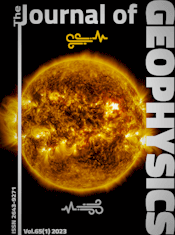Cross spectral analysis of Swabian Jura (SW Germany) three-component microearthquake recordings
Article Sidebar

Vols. 1-18 (1924-1944), ISSN 0044-2801
Main Article Content
Abstract
Similar three-component microearthquake records have been observed in the Swabian Jura (SW Germany) seismic zone for different source-receiver geometries. This data set is used to study the resolution power of cross spectral analysis techniques for the estimation of relative differential times as well as the applicability to velocity monitoring. The differential times are estimated in the frequency domain by assuming a linear-phase cross spectrum with the slope indicating the individual time difference. All earthquakes have been relocated with respect to a master event, using the relative P and S delay times from the cross spectral analysis as a measure of source mislocation. The overall location error is strongly dependent on the inital distance between master and studied event. For earthquakes initially located farther apart than approximately 1.5 km, the relocalization result in terms of total location error was poorer, whereas for events initially located closer than 1 km the precision of the relocalization was improved. The remaining residuals are of the order of 10 ms, which is approximately 3 times the digitization interval. In order to test the applicability of cross spectral analysis to velocity monitoring, synthetic data were used to model the influences of noise and source time function differences. The effect of additive white noise seems to be acceptable in cases where the S/N ratio is sufficiently high. Small changes in the shape of the source time function, however, were found to be of great influence to the differential time estimates. Variation of rise, sustain and decay times, which were negligible in the coherence spectrum, spuriously introduced phase differences which, in terms of delay times, easily reach the magnitude of the digitization interval. Thus, velocity monitoring using cross spectral analysis techniques seems to depend strongly on the equality - in contrast to similarity - of the source time functions of the events which are compared. The coherence spectrum is not a sufficient measure to detect all the significant differences.
 ARK: https://n2t.net/ark:/88439/y035103
ARK: https://n2t.net/ark:/88439/y035103
Permalink: https://geophysicsjournal.com/article/213
Article Details
References
Evernden, J.F. (1969) Identification of earthquakes and explosions by use of teleseismic data. J. Geophys. Res. 74:3828-3856
Frechet, J. (1985) Sismogenese et doublets sismiques. Ph.D. thesis, University of Grenoble, 206 pp.
Fremont, M.J. (1984) Mesure de variations temporelles des parametres de la croute terrestre et d'effets de sources par traitement de doublets de seismes. Ph.D. thesis, University of Grenoble, 220 pp.
Gelbke, C. (1977) Erweiterung des Erdbebenlokalisierungsprogramms HYP071 (Lee and Lahr, 1972) um eine Laufzeitroutine fuer Mehrschichtenmodelle konstanter positiver und negativer Geschwindigkeitsgradienten. Geophys. Inst. Univ. Karlsruhe, 58 pp.
Haessler, H., Hoang-Trong, P., Schick, R., Schneider, G., Strobeck, K. (1980) The September 3, 1978, Swabian Jura earthquake. Tectonophysics 68:1-14
Haskell, N.A. (1960) Crustal reflection of plane SH waves. J. Geophys. Res. 65:4147-4150
Ito, A. (1985) High resolution relative hypocenters of similar earthquakes by cross-spectral analysis method. J. Phys. Earth 33:279-294
Kanasewich, E.R. (1981) Time sequence analysis in geophysics. The University of Alberta Press, 480 pp.
Langer, H. (1986) Seismotektonische Herdparameter und Ausbreitungseffekte bei Mikroerdbeben im Bereich der westlichen Schwaebischen Alb. Ph.D. thesis, University of Stuttgart, 113 pp.
Lee, W.H.K., Lahr, L.C. (1972) HYP071: A computer program for determining hypocenter, magnitude and first motion pattern of local earthquakes. U.S. Geol. Survey, Open File Report, 113 pp.
Poupinet, G., Ellsworth, W.L., Frechet, J. (1984) Monitoring velocity variations in the crust using earthquake doublets: An application to the Calaveras Fault, California. J. Geophys. Res. 89:5719-5731
Poupinet, G., Frechet, J., Ellsworth, W.L., Fremont, M.J., Glangeaud, F. (1985) Doublet analysis: Improved accuracy for earthquake prediction studies. Earthq. Predict. Res. 3:147-159
Scherbaum, F. (1986) Die seimische Erkundung des Stationsuntergrundes mit Nahbebenseismogrammen. Habilitation thesis, University of Stuttgart, 209 pp.
Scherbaum, F., Stoll, D. (1983) Source parameters and scaling laws of the 1978 Swabian Jura (Southwest Germany) aftershocks. Bull. Seismol. Soc. Am. 73:1321-1343
Scherbaum, F., Stoll, D. (1985) The estimation of Green's function from local earthquake recordings and the modelling of the site response. Phys. Earth Planet. Inter. 38:189-202
Turnovsky, J., Schneider G. (1982) The seismotectonic character of the September 3, 1978, Swabian Jura earthquake series. Tectonophysics 83:151-162











